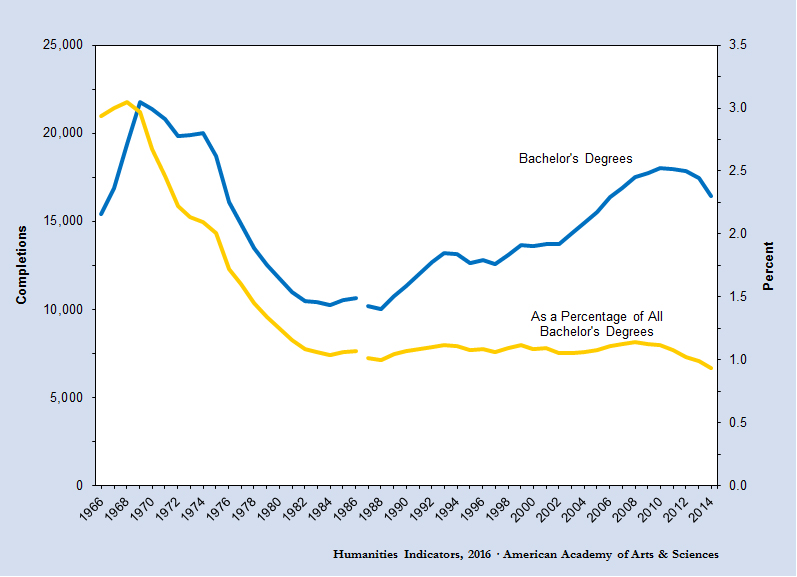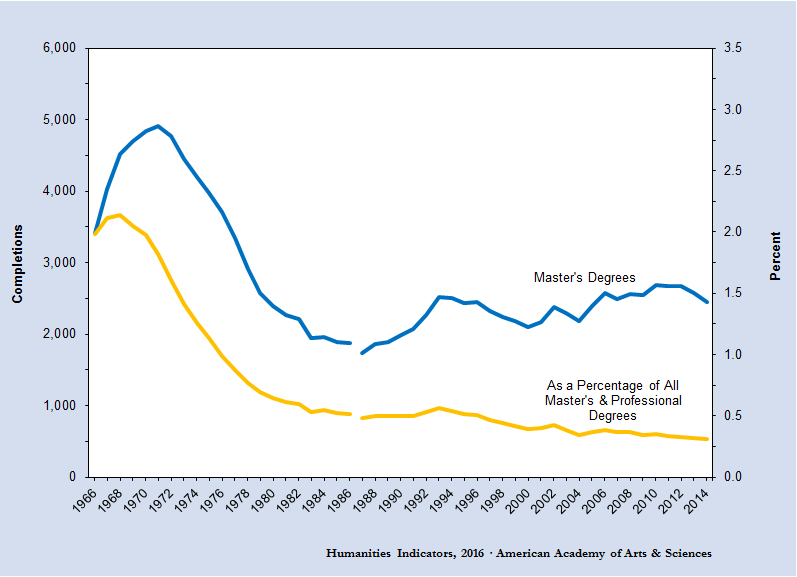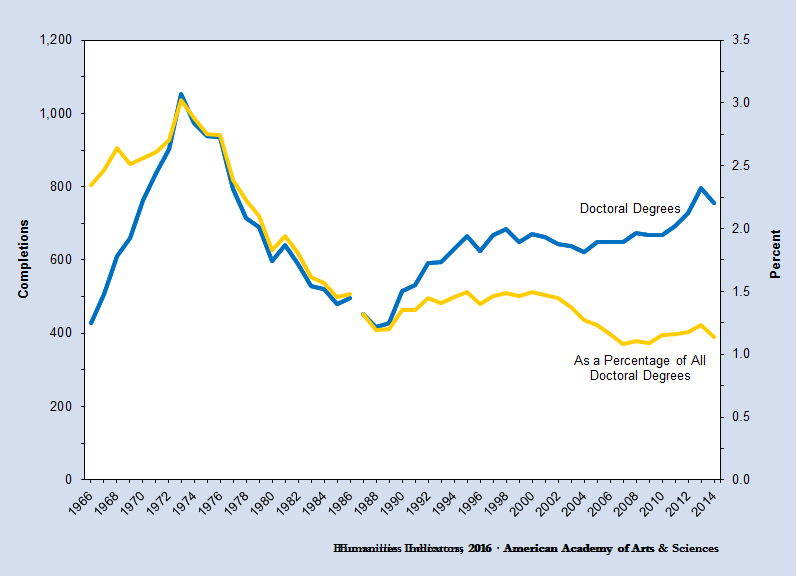Degree Completions in Languages and Literatures Other than English
- The number of LOTE degrees fell at all levels in the second decade of the 21st century, although the timing of the decline differed by degree level (Indicators II-46a, II-46b, and II-46c). At the bachelor’s level, the number of degrees in LOTE fell 8.7%, from a recent peak of 18,007 in 2010 to 16,445 in 2014. The number of LOTE students earning master’s degrees followed a similar path—falling 8.6% over the same time span (from 2,682 to 2,452). Decline came somewhat later at the doctoral level, where the recent peak in the number of degrees occurred in 2013 (796), followed by a 5% drop in 2014 (to 756).
- The number of students awarded LOTE degrees declined steadily from the early 1970s to the late-1980s (falling slightly more than 60% at the master’s and doctoral levels and 54% at the bachelor’s level) before rising again into the 2000s. The number of LOTE bachelor’s degrees peaked again in 2010 (at 83% of the 1969 zenith) before falling to 75% of the 1969 peak by 2014. The number of LOTE master’s degrees also rose through the 2000s, to almost 55% of the 1971 zenith, but by 2014 had fallen to half of that peak.
- For Ph.D. awards, the highest level of recovery from the deep slump of the 1980s came in 2013, when LOTE degree completions reached 76% of their 1973 high. With the drop in 2014, the number of doctoral degrees in the discipline fell to 72% of the peak.
- At the height of their popularity in the late 1960s and early 1970s, LOTE degrees represented approximately 3% of all degrees at the bachelor’s level and 2% of master’s degrees. The share of degrees earned in LOTE then declined from the early 1970s, plateauing in the mid-to-late 1980s. The share started to decline again in 1994 at the master’s level and in 2009 at the bachelor’s. As a share of all bachelor’s degrees awarded, LOTE fell to the lowest level on record in 2014 (0.93%)—less than a third of the 1968 peak. The discipline’s share of all master’s degrees also fell to a new low in 2014 (0.31%), less than 15% of the historic high.
- The decline in LOTE’s share of doctoral degrees beginning in the 1970s was somewhat less pronounced than for bachelor’s and master’s degrees. The share fell from a high of 3.0% in 1973 to 1.2% in 1988, rose as high as 1.5% in 1995 and again in 2000, but then fell below 1.1% in 2007 and remained near that level through 2014.
II-46a: Bachelor’s Degree Completions in Languages and Literatures Other than English (Absolute Number and as a Percentage of all Bachelor’s Degrees), 1966–2014*

* The gaps in the trend lines for 1987 indicate a shift from the National Science Foundation’s disciplinary classification system to the National Center for Education Statistics’ Classification of Instructional Programs. Please see the Note on the Data Used to Calculate the Number of Degree Completions in English Language and Literature and in Languages and Literatures Other than English for an explanation of the differences between the two systems that are most pertinent to this indicator. Degree counts exclude second majors.
Source: U.S. Department of Education, Institute of Education Sciences, National Center for Education Statistics, Integrated Postsecondary Data System; accessed via the National Science Foundation’s online integrated science and engineering resources data system, WebCASPAR.
See the Note on Data Used to Calculate Discipline-Specific Degree Counts and Shares and the Note on the Data Used to Calculate the Number of Degree Completions in English Language and Literature and in Languages and Literatures Other than English. Data on the number of students completing minors are not gathered as part of the data collection program from which these degree completion counts are drawn, but such information was compiled for selected humanities disciplines as part of the American Academy of Arts and Sciences–sponsored Humanities Departmental Survey.
II-46b: Master’s Degree Completions in Languages and Literatures Other than English (Absolute Number and as a Percentage of All Master’s and First Professional Degrees), 1966–2014*

* The gaps in the trend lines for 1987 indicate a shift from the National Science Foundation’s disciplinary classification system to the National Center for Education Statistics’ Classification of Instructional Programs. Please see the Note on the Data Used to Calculate the Number of Degree Completions in English Language and Literature and in Languages and Literatures Other than English for an explanation of the differences between the two systems that are most pertinent to this indicator.
Source: U.S. Department of Education, Institute of Education Sciences, National Center for Education Statistics, Integrated Postsecondary Data System; accessed via the National Science Foundation’s online integrated science and engineering resources data system, WebCASPAR.
II-46c: Doctoral Degree Completions in Languages and Literatures Other than English (Absolute Number and as a Percentage of All Doctorates), 1966–2014*

* The gaps in the trend lines for 1987 indicate a shift from the National Science Foundation’s disciplinary classification system to the National Center for Education Statistics’ Classification of Instructional Programs. Please see the Note on the Data Used to Calculate the Number of Degree Completions in English Language and Literature and in Languages and Literatures Other than English for an explanation of the differences between the two systems that are most pertinent to this indicator.
Source: U.S. Department of Education, Institute of Education Sciences, National Center for Education Statistics, Integrated Postsecondary Data System; accessed via the National Science Foundation’s online integrated science and engineering resources data system, WebCASPAR.

